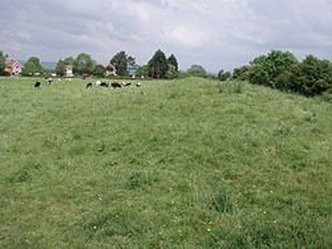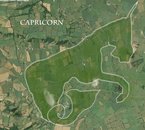Things to do and places to see in Glastonbury:
Ponter's Ball

Ponter’s Ball is a geomantic linear Earthwork lying south-east of the Tor on raised ground between what were once marshes. The name Ponter's Ball is said to be derived from "pontis vallum", Latin meaning "the bridge over the ditch". Nearly one mile long it runs from marsh edge to marsh edge and straddles the narrow strip of land that links the Isle of Avalon with the high ground rising eastward towards Shepton Mallet.
It was excavated in 1909 by Arthur Bulleid, and again in 1970 by Peter Poyntz Wright and the Glastonbury Antiquarian Society. Bulleid's excavation just north of the road revealed that the bank was 9 feet high and made of layers of yellow and grey clay, while the ditch was 12 feet deep in hard blue marl. Neither excavation found significant objects with the exception of fragmentary pottery of prehistoric and medieval origin.
Interpretation of the site is not clear. It is possible that it was part of a longer defensive barrier associated with New Ditch three miles to the south-west which is built in a similar manner. It has been suggested that it is part of a great Celtic sanctuary, probably 3rd century B.C., while others date it to the post-Roman period and connect it with the Dark Age occupation on Glastonbury Tor. The 1970 excavation suggests the 12th century or later. ["PONTER'S BALL". PastScape. English Heritage]
It was excavated in 1909 by Arthur Bulleid, and again in 1970 by Peter Poyntz Wright and the Glastonbury Antiquarian Society. Bulleid's excavation just north of the road revealed that the bank was 9 feet high and made of layers of yellow and grey clay, while the ditch was 12 feet deep in hard blue marl. Neither excavation found significant objects with the exception of fragmentary pottery of prehistoric and medieval origin.
Interpretation of the site is not clear. It is possible that it was part of a longer defensive barrier associated with New Ditch three miles to the south-west which is built in a similar manner. It has been suggested that it is part of a great Celtic sanctuary, probably 3rd century B.C., while others date it to the post-Roman period and connect it with the Dark Age occupation on Glastonbury Tor. The 1970 excavation suggests the 12th century or later. ["PONTER'S BALL". PastScape. English Heritage]

Research into the Glastonbury Zodiac has shown that the long single horn
on the head of the Capricorn effigy is perfectly delineated by Ponter’s Ball.
More places to visit in Glastonbury
Bride's Mound | Chalice Well & Gardens | The Church of St John the Baptist | Glastonbury Abbey |
The Glastonbury Experience Courtyard | Glastonbury Goddess Temple | Glastonbury Thorn |
Gog & Magog | Lake Village Museum | Library of Avalon | St. Margaret's Chapel & the
Magdalene Almshouses | Somerset Rural Life Museum | Ponter's Ball |
The Glastonbury Tercentennial Labyrinth | Glastonbury Tor | Wearyall Hill | White Spring |
The Glastonbury Experience Courtyard | Glastonbury Goddess Temple | Glastonbury Thorn |
Gog & Magog | Lake Village Museum | Library of Avalon | St. Margaret's Chapel & the
Magdalene Almshouses | Somerset Rural Life Museum | Ponter's Ball |
The Glastonbury Tercentennial Labyrinth | Glastonbury Tor | Wearyall Hill | White Spring |
